
Hiking Club meets every Thursday

syəcəb

Submitted by AnneCherise Jensen,SNAP-Ed Coordinator
A healthy breakfast gives us the fuel and the energy we need to make it through the day. Believe it or not, our bodies are constantly burning calories, even when we are sleeping. After the recommended 8 hours of sleep each night, our bodies wake up craving “fuel” aka breakfast.
Research shows breaking an overnight fast with a well-balanced meal could make a significant difference in the overall health and well-being of individuals – especially for youth, teens and children. In fact, that’s where we get the word “break-fast” from, indicating you are breaking a 7-10 hour natural fast that happens while you are asleep. Skipping breakfast can lead to poor mood, low blood sugar, lack of energy and fatigue. However, eating a well-balanced breakfast with whole grains, lean protein, healthy fats, and fruits and vegetables can help improve behavior and school performance as well as foster a healthy weight.
Ultimately, eating breakfast helps us feel more alert, awake, and energized when we start our day. So it’s true when they say, breakfast really is the most important meal of the day. Here are some examples of some easy healthy breakfasts to start your day off right.
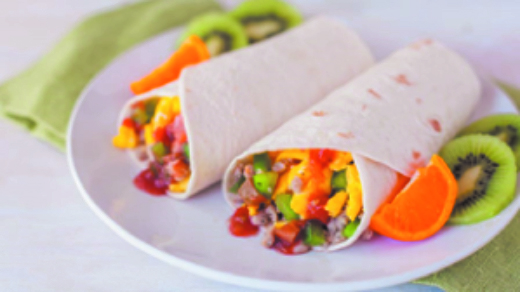
Baha Breakfast Burritos
Ingredients (Makes 4 servings)
Directions
Berry Good Banana Split
Ingredients Serves 1
Directions

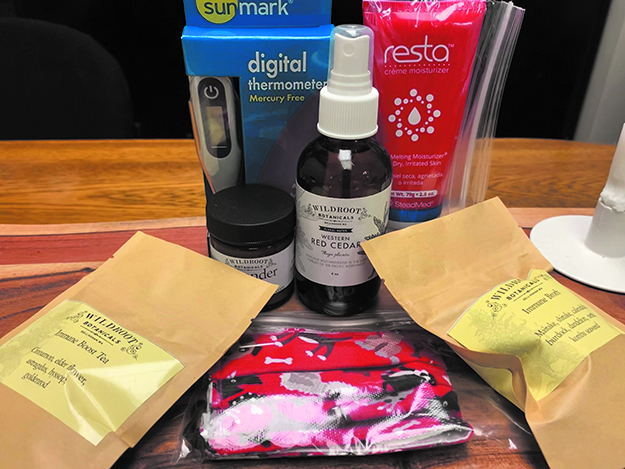
By Kalvin Valdillez, Tulalip News
When the Tulalip Tribes issued their Stay Home, Stay Safe mandate and the governmental entity placed many of its programs on hold and staff on furlough, due to the coronavirus, the Diabetes Care and Prevention program was among the few that momentarily halted all services.
“One of the things you hear on the news is about the people who are at high-risk of contracting the virus, and they always mention diabetes,” said Veronica ‘Roni’ Leahy, Diabetes Care and Prevention Program Coordinator. “I started thinking about what was happening with our patients, what they must be going through, how they are feeling. They must be worried and scared.”
Although there has been a general decrease in the total number of Indigenous people diagnosed with the disease over recent years, Native communities still have an alarmingly high amount of people who are diabetics and pre-diabetics in comparison to any other race nationally.
Diabetes, whether Type 1 or Type 2, is a complex disease that unfortunately, due to deviating from our traditional diets and the lack of access to healthy foods, has affected many of our loved ones and altered the way they live. Managing diabetes is not exactly a walk in the park, considering the amount of medication and insulin one must take in order to just eat a meal. If you are a diabetic and miscalculate the amount of insulin you need to take, or eat too much or too little, you can potentially be in life-threating danger if your blood sugar spikes or drops dramatically.
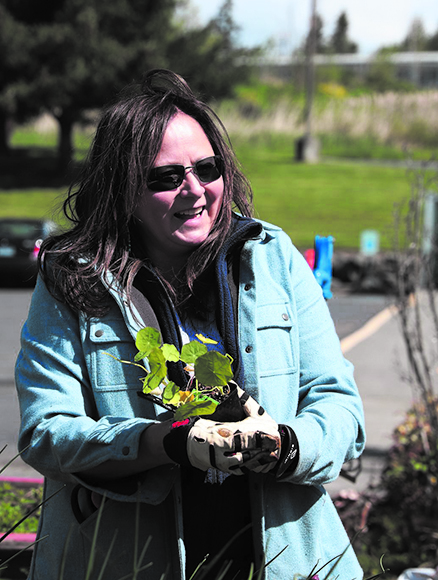
With the health of her patients in mind, Roni pleaded with management at the Tulalip Health Clinic, asking for clearance to come back and figure out a way to reach those patients living with diabetes. Receiving the okay to return, Roni immediately got to work by calling and checking-in on those diabetics who receive care through the program. Able to reach 121 out of 225 patients, Roni asked them a series of questions to get an understanding of how they were doing and what services they required amid the COVID outbreak.
Like many Tribal programs and departments, the Diabetes Care and Prevention program was gearing up for an exciting 2020, aiming to reach more of the community who have been diagnosed with pre-diabetes by planning classes, field trips and a number of fun projects including a fitness expo, complete with exercise workshops and activities, in partnership with Youth Services. With those plans no longer in-play, Roni had to readjust her approach to reach those who needed the program’s resources and services.
“Every month we send the patients a mailer to their homes; something that can provide them with information about COVID,” she explained. “The first one we sent had a thermometer, information on COVID-19 and safety guidelines. This way they know wearing masks are important; we sent them one set and in the next mail-out they’ll get another set of masks.”
In addition to reliable information, Roni is also making sure her patients have the necessary equipment to monitor their health, including blood pressure monitors, thermometers, spirometers and fingertip oximeters, in order to accurately report to their doctors during scheduled telehealth appointments. The program has also been working with other departments within the tribal health clinic that provides services to their diabetic clients. For example, optometry provided Roni with eye health information handouts and eye drops, while the in-house physical therapist offered resistance bands and exercises, so the diabetics can stay active safely from the comforts of their homes.
The mail-out program is a monthly initiative to help those living with diabetes navigate through these corona-times safely. The Diabetes Program also assembles themed-care packages that are sent to their clients quarterly. Last quarter, those diabetics who live on the reservation received a cold care package, filled with immune boosting essentials, at their doorstep. The care packages are hand-delivered by the Diabetes Program Admin Assistant, Brooke Morrison. And for those diabetics who do not live on the reservation, they are able to scoop one up at any time from the health clinic. The next care package will be a naturopathic kit.
During Roni’s telephone assessment, she asks the patient if an emergency situation occurred, do they feel comfortable calling the clinic or the medics, whether it was a diabetic or corona related issue. Many of those patients voiced concern.
“I want them to know that if they have worries or anxieties about calling the office for care because they’re afraid of getting sick, they can call us. A lot of people don’t want to call because they are afraid they’ll have to go to the hospital, and if they go to the hospital their family can’t be with them. That’s part of the conversation I have with them and let them know that you can talk to our nurses, to our clinic and they can help you. Maybe you don’t have to go to the hospital, but you do need to call somebody.”
When reaching out to her patients, Roni quickly learned that a phone call goes a long way. In fact, she recalled numerous phone conversations that resulted in tears. Many of her clients expressed fear about the uncertainty surrounding the coronavirus, as well as loneliness caused by isolation. Roni shared that one gentleman told her that she was actually the first person to call and check on him since the pandemic began.
“We’re keeping really busy with diabetes education that keeps people active and on track with social distancing and keeping things sanitized. Our biggest concern is their safety and we want them to know that we’re here for them,” Roni expressed. “When it comes to diabetic care, sometimes it can be a lonely walk and filled with a lot of uncertainty. We want them to understand that they’re not alone. The mail-out program is a great way to keep interacting with our patients. One of the things people enjoy about our classes is that connection of being together as a group, so we still need to keep those relationships alive and growing and we do that by making sure they have everything they need at home.”
For more information, please contact the Tulalip Diabetes Care and Prevention Program at (360) 716-5641.

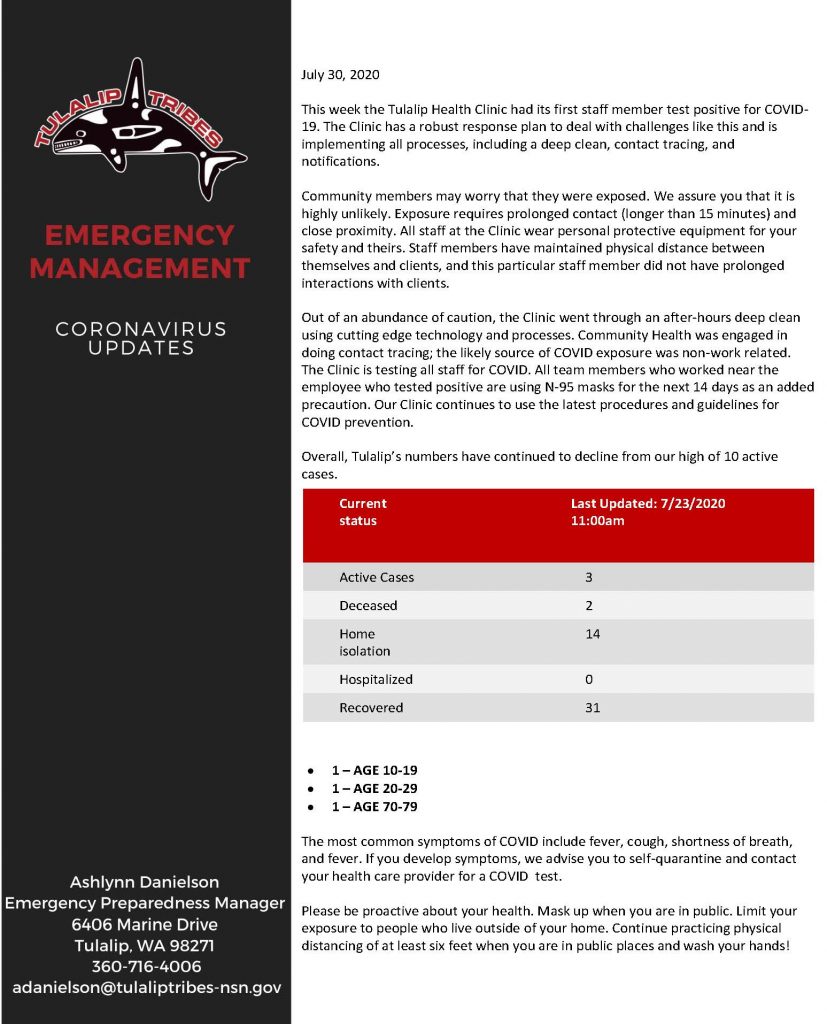

By Kalvin Valdillez, Tulalip News
Masks seem to be at the center of many heated debates in today’s society. Conspiracy or not, the Tulalip Tribes passed a ‘no mask, no service’ resolution at the beginning of July, requiring individuals to wear masks in all public spaces within the Tulalip reservation, including tribal establishments, gaming and government, as well as at local businesses. The decision was made in response to a recent rise in COVID-19 cases on the reservation after a long period with zero reported cases after the initial outbreak, as the Tribe acted swiftly to prevent the virus from spreading any further.
“I think right now with COVID-19 being as serious as it is, social distancing and the proper PPE (personal protective equipment) are important,” expressed Marysville UniFirst Branch Manager, Justin England. “I think if everyone has enough PPE then they can stay safe and keep their families safe.”
UniFirst is a nationwide corporation that specializes in providing uniforms and safety gear for businesses at 260 locations. With cases spiking throughout the entire country, UniFirst began a corporate initiative to assist business owners during the global pandemic.
“We’re taking part in a company-wide initiative, partnering with businesses in our local communities across the country,” explained Justin. “UniFirst is donating 10,000 masks in a lot of communities. I was approached by someone at our corporate office asking if we’d like to be a part of this with our community and I said I’d love to. When they asked who I’d like to partner with, being in Marysville, my first thought was the Tulalip Tribes. That’s when I reached out, hashed out the details, partnered up and made this happen.”
On the afternoon of July 22, Justin hand-delivered several boxes filled with blue surgical masks to the Tulalip Tribes Office of Emergency Management team at the Tulalip Administration building.
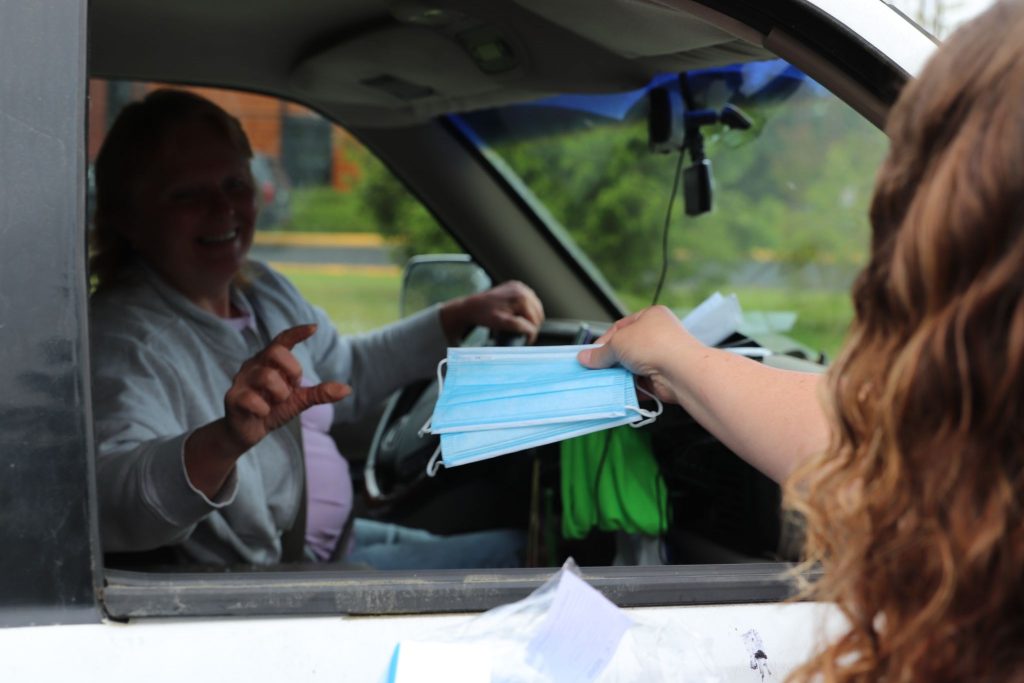
A misunderstanding occurred when UniFirst revealed they would be distributing the masks to the Tribe as a local news team announced that Tulalip was handing out masks to the public. The announcement sent many on a course headed to the Tribe’s admin building. And though explaining the kerfuffle to them, Tulalip’s Emergency Preparedness Manager, Ashlynn Danielson still provided those who made the journey to the rez with one mask each for their troubles. The majority, save for the few handed out that afternoon, will be distributed to business establishments throughout Tulalip and Quil Ceda Village.
“The thought concept behind these masks were to support our local businesses, the smaller mom and pop shops,” Ashlynn stated. “They can reach out and we can provide them with masks to have on-hand. In the event that their patrons come in and either forgot their masks or don’t own a mask, the company can provide them with a free mask and still do business with them.”
“We’re also planning to give the Tulalip police officers masks,” she continued. “As the officers come in contact with civilians who aren’t wearing a mask, they could ask them if they’d like to have a mask and request that they wear one, and also expand on why it’s important to wear masks.”
The Center for Disease Control recently issued a press release urging Americans to wear face masks to slow the spread of the virus throughout the Nation. There are some, however, who feel that governmental entities that mandate its citizens to wear a mask is a violation of their constitutional rights and t refuse to wear one.
The Tulalip Office of Emergency Management will be distributing the masks to local businesses in the near future. To stay updated on all the latest COVID-19 info, please follow Tulalip News on Facebook, Twitter and Instagram or visit the Tulalip Coronavirus Response website.
“We are in unknown territories,” admits Ashlynn. “COVID-19 is not something you plan for; it didn’t exist. Knowing that we have groups coming together and that our tribal membership and community members are listening about wearing masks, recognizing that what we’re telling them is true – you need to mask, it helps protect everyone, you and your loved ones – I would say that this donation really warms my heart.”

Submitted by Tulalip Tribes SNAP-Ed Coordinator, AnneCherise Jensen.
Did you know the U.S. spends $117 Billion dollars in annual health care costs associated with inadequate physical activity? According to the CDC, only half of adults get the physical activity needed to help reduce and prevent chronic diseases. Believe it or not, getting enough physical activity could prevent 1 in 10 premature deaths. More and more research suggests that living an active lifestyle can help prevent certain types of diseases like Heart Disease, Type 2 Diabetes, and certain types of cancer. Not only that, but physical activity helps boost the feel good hormones in our brain, helping us feel more content and happy.
The CDC recommends individuals should get at least 150 minutes a week of brisk physical activity and at least two days a week of muscle strengthening activities. Though, it can be hard getting in the habit of being active, when you start small, you can slowly build yourself up to more challenging activities. Here are some tips on how to incorporate a more active and healthy lifestyle, so you and your family can live your healthiest and happiest life.
Evening and Morning Walks: Start and end your day with a brisk walk. Getting small doses of physical activity at the beginning of the day, helps wake you up and feel more alert. Taking walks in the evening is a great way to burn off the post dinner calories and enjoy the late summer sunsets. If you feel up to it, try jogging to build cardio and lung capacity.
Family Bike Rides: If you have a few bikes on hand, try planning a family bike outing in your local neighborhood. Riding bikes is a fun and exciting physical activity kids are eager to participate in. To be safe, make sure to wear a helmet and stay in the bikelane or on the sidewalk. Gardening: Gardening, weeding and spending time in the yard is a great way to increase physical activity throughout the day. Not only does this get you moving, but allows you to connect with nature, while learning more about plants and food. Gardening also has been known to be therapeutic and relaxing to many individuals. If you don’t know how to garden, there are hundreds of books and youtube videos that can help point you in the right direction.
Stretching / Yoga: Stretching is one of the best forms of exercise. Stretching keeps the muscles strong, healthy and flexible. Without stretching, muscles would shorten and become tight. Other known benefits of stretching include: improved posture, decreased neck and back pain, increased blood flow, a deeper and more peaceful nights sleep, mental clarity and stress reduction. Create a safe space in your home where you can spend 15-30 minutes stretching a day.
Hiking: Hiking is one of the best forms of exercise you can do for your body, especially in the summer months when the mountain trails are accessible. Not only do you get a great cardio exercise, but also a bone and muscle strengthening exercise. For more information on hiking ideas + safety, check out WTA.ORG.
At home workout station: You don’t need a ton of space to be able to get in a good workout. Try creating an at home work out station in your backyard or garage. Start by collecting affordable equipment like a jump rope, resistance bands, and small weights. If you don’t have equipment, you can improvise and use canned goods, filled water bottles, or even tools as weights. Practice stretching in place, getting repetitions of squats, sits ups, jumping jacks, and knee kicks. Be sure to check out online fitness videos or smart phone apps for professional workout routines.
Foraging / Harvesting: Participating in foraging and harvesting is a great way to connect with culture, nature, plants and the human spirit. The outdoors have so much to offer, and learning cultural traditions is a great way to stay moving while getting more physical activity. Not only is this challenging for the body, but for the mind as well.
Home Improvement Projects: Accomplishing tasks around the house is a terrific way to stay moving and motivated throughout the year. Home improvement projects can vary from a wide variety of tasks, including yard work, carpentry, landscaping, building, and fixing up the house. Many of these projects require the use of muscle, strength and skill – all good for the body and the mind.
Outdoor games with kids: Children love interactive engagement with parents/adults. This is a great opportunity to squeeze in both physical activity and quality family time. Try classic games like tag, frisby, and sharks and minnows. Check out the local basketball court and go shoot some hoops. On a real hot summer day, organize a water balloon fight for both parents and kids to enjoy.
Cleaning & Organization Projects: Cleaning and organizing your home is a great way to stay active. Not only that, but it can help ease feelings of depression and anxiety. Having a clean space is a key to inviting a happy, peaceful and calm atmosphere into the home.
Take the Stairs: When you get the opportunity, always take the stairs. A few flights of stairs may not seem like a lot of physical activity at first, but doing this often will add up to great results. Doing so will help you burn more calories throughout the day, while building lung capacity, strengthening your bones and stimulating muscle growth!
Make Screen Time an Active Time: When family TV time comes along, get creative and turn lazy time into active time. Have a contest to see who can do the most push-ups or jumping jacks during a commercial break. Older kids and adults can stretch, practice yoga or lift weights while watching TV.
Know there are many other forms of physical activity you can do to help keep active. These are just a few common ideas to help get your fitness journey started. Know that ultimately, you are in control of your body and capable of doing amazing things!
**This material was funded by USDA’s Supplemental Nutrition Assistance Program – SNAP. This institution is an equal opportunity provider.
Sources: https://www.cdc.gov/physicalactivity/about-physical-activity/why-it-matters.html

By Kalvin Valdillez, Tulalip News
“I really want people to know that they can reach out in any capacity at any time,” said Tulalip Legacy of Healing and Child Advocacy Center Manager, Jade Carela. “And remind people that though things might be slowed down and we might be doing things a little differently, we’re still here for you.”
For years the Tulalip Legacy of Healing (LOH) and Child Advocacy Center (CAC) have represented safety, healing, hope and new beginnings for many Tribal members looking to escape sexually abusive or violent relationships. Typically, the LOH and CAC staff are busy year-round raising awareness for the victims of DV and survivors of sexual assault.
For instance, April is National Child Abuse Prevention Month and Sexual Assault Awareness Month, and that month alone is jam-packed with a number of seminars, panels and classes aimed to provide a safe space for victims to speak, express their emotions and begin the healing process. The month also is held in part to educate the community about what sexual assault is, how often it occurs and how to identify warning signs. But with the presence of the pandemic, the LOH and CAC team was met with a number of challenges that they were forced to quickly overcome in order to ensure their clients, and anybody in need of their services, could access them.
“When COVID first happened, we moved everything to tele,” Jade explained. “Tele just means that we’re providing that service from home. And the therapists are also doing mental health services from home. We really don’t see anybody in-person anymore. I took on our lead advocate’s phone, so we still respond to emergencies and anything that comes up.”
Last month, Tulalip Child Advocate, Sydney Gilbert, hand-delivered fliers to businesses located on the reservation out of concern that people, especially children, are less likely to report due to the coronavirus pandemic.
“We’re really trying to focus on the fact that we have to rely on everyone, on each other, right now to look out for the safety of kids,” Sydney stated. “Because they are not with their teachers on a regular basis, they’re not with other kids, they aren’t even with other family members who they can disclose that information to. There are a lot of kids stuck at home with their abuser, with no access to a mandated reporter, no way to escape that environment that they’re in.”
A decision was recently made to close the Tulalip Legacy of Healing Safe House indefinitely, but Jade wants to ensure the community the LOH department still has plenty of resources and can help direct individuals seeking refuge to a nearby shelter or safe house.
“The Legacy of Healing is still there; we just don’t have a safe house anymore, but we have other places that we know of where there are shelters,” said Jade. “If you are Native, we work with a place in Seattle that provides assistance when it comes to needing a hotel or things like that. Even though we don’t have our safe house, there’s other Native safe houses within Washington State that we have a good relationship with, and there’s also other shelters that we have good relationships with. We still have the advocate and attorney right now who’s able to help with our cases.”
In addition to passing out informational fliers, the Tulalip LOH and CAC recently launched their Facebook page where they plan to share various articles and educational pieces surrounding heavy topics such as domestic violence and sexual abuse.
“This information is important because the abuse is still happening, whether we’re seeing it or not,” said Jade. “We need to be there for them, even if it’s just one child or one adult that comes forward with something that’s been going on. They need that support, they need someone there, and they need a service that’s going to be thinking of their best interest while going through this process. We’re always here, so reach out. We can be on the court calls with you and connect you with the attorneys. We can talk with you, we can offer other resources to you, we are here for you.”
For more information, please contact the Tulalip Legacy of Healing at (360) 716-4100 or the Tulalip Child Advocacy Center at (360) 716-KIDS (5437), and be sure to also give their new Facebook page a follow.
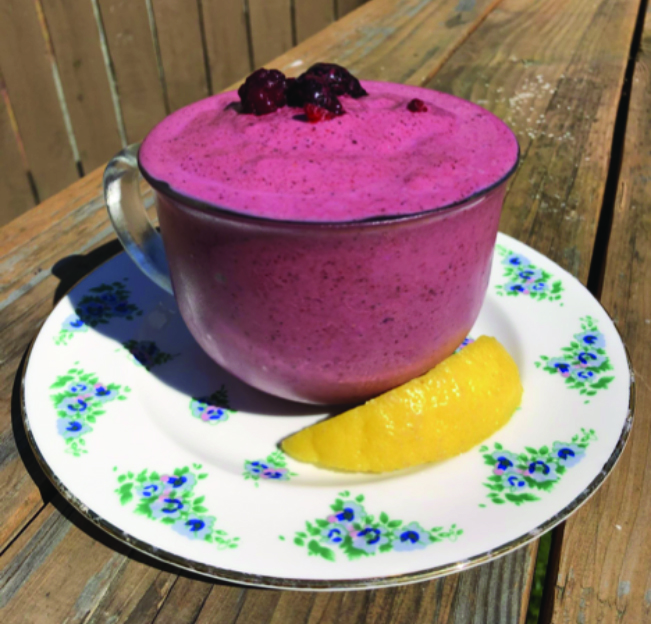
Submitted by SNAP-Ed Coordinator, AnneCherise Jensen
In today’s day and age, it can be a challenge to get kids to eat their fruits and vegetables. With processed and fast foods so easily convenient, getting kids to eat a healthy well balanced meal can be a chore. However, it’s extremely important that kids eat foods high in nutrients to ensure their growth is adequate going into adulthood. Most children and teens need to eat every 3-4 hours throughout the day to fuel their growing, active bodies. Children should be eating 3 meals and 1-2 snacks a day. If they are more physically active or going through a growth spurt, they may require even more nutritious snacks. It’s recommended to have a total of at least 5 servings of fruits and vegetables a day. This can mean 2 servings of fruits and 3 servings of vegetables, or 1 serving of vegetables and 4 servings of fruits. Here are some easy tricks to help get your children to eat a more well balanced diet!
Offer Taste Testings: Children are often hesitant when trying new foods, especially fruits and vegetables. Try offering taste testings frequently, especially while kids are young. This will get them in the habit of trying new foods and exploring their taste buds. Talk about what qualities they experience while trying new foods – is it sour, salty or sweet? What is the texture like? What color is the food? What does it look like and where does it come from? Having in depth conversations like this with children while they are young will help them develop a healthy relationship with food as they grow. They may not end up liking all the foods they try, but they will find new foods they do like along the way. The important part is, encouraging them to try.
Make Meals Simple: Don’t over season or make meals complicated. The simpler, less seasoned the dish is, the more likely the children will eat the desired food. Kids taste buds are much more sensitive at a young age, and tend to gravitate to simple flavors. Try to limit excessive sweetened or saltend foods, also.
Sneak In Healthy Ingredients: Can’t get your kids to try fruits and vegetables? Try sneaking them into foods. If you cut up produce small enough, once it’s cooked into the dish, children may not even notice they are there. Onions, mushrooms, peppers, tomatoes, and spinach are common vegetables that can be snuck into any pasta, soup or casserole dish.
Allow kids to have a say in the produce department: Plan a fun trip to a grocery store or farmers market with your children. If you are limiting the number of household members shopping at one time, kids can help make the shopping list. Allow kids to have a say in what produce is chosen. Have your kids take a look at some recipe books and encourage them to pick out healthy recipes. The more you involve the children in the process, the more inclined they will eat the fruits and vegetables once you are home.
Invite kids to cook with you in the kitchen: The best way to teach kids about eating right, is getting them involved in the kitchen. Cooking is a valuable life skill that teaches children about nutrition and food safety, as well as building math, science, literacy and fine motor skills. Chores your children can do in the kitchen include; rinsing produce in the sink, tearing lettuce, slicing fruits and vegetables, cooking with the microwave oven, creating a fruit and vegetable tray, and setting the table for dinner time.
Parents as Role Models: Many children will eat foods and follow eating patterns their parents and older family members set. Lead by example. Choose to eat a wide variety of healthy meals, and be the example your children need. They may fight eating healthy foods while they are young, but as they get older and their taste buds change, they will most likely eat foods their parents and role models eat at the dinner table.
Here are some kid friendly fruit and vegetable ideas to try at home:
Homemade Frozen Yogurt
Ingredients:
Directions:
Note: You can substitute or add any fruit ingredients into the frozen yogurt. Try adding peaches, bananas or even some coconut flakes to give it more flavor and texture. This is a great time to get creative in the kitchen, the possibilities are endless!
**This material was funded by USDA’s Supplemental Nutrition Assistance Program – SNAP. This institution is an equal opportunity provider.
Source: